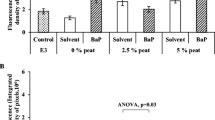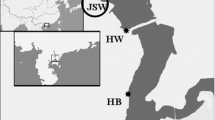Abstract
Toxic risks of sediments collected from seven sites in Tokyo Bay were evaluated using Japanese medaka embryos. Those sediments with slight pore water were placed in grass petri dishes without overlying water. The most remarkable effect in the field sediment was to cause hatching delay in embryos, and the longest time until hatching took was 12.5 ± 1.6 days post-fertilization (dpf), although that in control group was 10.1 ± 0.7 dpf. A significant delay in hatching was observed at four sites. Because total carbon concentrations were relatively high in sediments at three of these four sites, several chemicals were expected to be residues in these sites and could cause their delay. Although extreme mortality was not observed at all sites, sediments collected from the site close to Kawasaki city induced 10 % mortality. Polycyclic aromatic hydrocarbon (PAH) concentrations were remarkably high at this site compared with other sites, and thus PAH toxicities could be causing the mortality. Concentration of heavy metals such as cadmium, copper, lead, and zinc in sediments were also determined, but no clear relationship was found between toxicities to embryos and the distribution of their concentrations.


Similar content being viewed by others
References
Barjhoux I, Baudrimont M, Morin B, Landi L, Gonzalez P, Cachot J (2012) Effects of copper and cadmium spiked-sediments on embryonic development of Japanese medaka (Oryzias latipes. Ecotoxicol Environ Saf 79:272–282
Barjhoux I, Cachot J, Gonzalez P, Budzinski H, Le Menach K, Landi L, Morin B, Baudrimont M (2014) Transcriptional responses and embryotoxic effects induced by pyrene and methylpyrene in Japanese medaka (Oryzias latipes) early life stages exposed to spiked sediments. Environ Sci Pollut Res 21:13850–13866
Barron MG, Carls MG, Heintz R, Rice SD (2004) Evaluation of fish early life-stage toxicity models of chronic embryonic exposures to complex polycyclic aromatic hydrocarbon mixtures. Toxicol Sci 78:60–67
Carls MG, Holland L, Larsen M, Collier TK, Scholz NL, Incardona JP (2008) Fish embryos are damaged by dissolved PAHs, not oil particles. Aquat Toxicol 88:121–127
Cheng J, Flahaut E, Cheng SH (2007) Effect of carbon nanotubes on developing zebrafish (Danio rerio) embryos. Environ Toxicol Chem 26:708–716
Chikae M, Hatano Y, Ikeda R, Morita Y, Hasan Q, Tamiya E (2004) Effects of bis(2-ethylhexyl) phthalate and benzo[a]pyrene on the embryos of Japanese medaka (Oryzias latipes. Environ Toxicol Pharmacol 16:141–145
Coors A, Dobrick J, Möder M, Kehrer A (2012) Mixture toxicity of wood preservative products in the fish embryo toxicity test. Environ Toxicol Chem 31:1239–1248
Dave G, Xiu R (1991) Toxicity of mercury, copper, nickel, lead, and cobalt to embryos and larvae of zebrafish, Brachydanio rerio. Arch Environ Contam Toxicol 21:126–134
Hallare AV, Kosmehl T, Schulze T, Hollert H, Köhler H-R, Triebskorn R (2005) Assessing contamination levels of Laguna Lake sediments (Philippines) using a contact assay with zebrafish (Danio rerio) embryos. Sci Total Environ 347:254–271
Hollert H, Keiter S, König N, Rudolf M, Ulrich M, Braunbeck T (2003) A new sediment contact assay to assess particle-bound pollutants using zebrafish (Danio rerio) embryos. J Soil Sediment 3:197–207
Horng CY, Lin HC, Lee W (2010) A reproductive toxicology study of phenanthrene in medaka (Oryzias latipes. Arch Environ Contam Toxicol 58:131–139
Hosono T, Su CC, Okamura K, Taniguchi M (2010) Historical record of heavy metal pollution deduced by lead isotope ratios in core sediments from the Osaka Bay, Japan. J Geochemical Explor 107:1–8
Isobe T, Nishiyama H, Nakashima A, Takada H (2001) Distribution and behavior of nonylphenol, octylphenol, and nonylphenol monoethoxylate in Tokyo metropolitan area: their association with aquatic particles and sedimentary distributions. Environ Sci Technol 35:1041–1049
Isobe T, Serizawa S, Horiguchi T, Shibata Y, Managaki S, Takada H, Morita M, Shiraishi H (2006) Horizontal distribution of steroid estrogens in surface sediments in Tokyo Bay. Environ Poll 144:632–638
Iwamatsu T (2004) Stages of normal development in the medaka Oryzias latipes. Mech Dev 121:605–618
Koyama J, Kitoh A, Nakai M, Kohno K, Tanaka H, Uno S (2013) Relative contribution of endocrine-disrupting chemicals to the estrogenic potency of marine sediments of Osaka Bay, Japan. Water Air Soil Pollut 224:1570–1579
Le Bihanic F, Clérandeau C, Le Menach K, Morin B, Budzinski H, Cousin X, Cachot J (2014) Developmental toxicity of PAH mixtures in fish early life stages. Part II: adverse effects in Japanese medaka. Environ Sci Pollut Res 21:13732–13743
Long E, MacDonald D, Smith S (1995) Incidence of adverse biological effects within ranges of chemical concentrations in marine and estuarine sediments. Env Manag 19:81–97
Masunaga S, Yao Y, Ogura I, Sakurai T, Nakanishi J (2003) Source and behavior analyses of dioxins based on congener-specific information and their application to Tokyo Bay basin. Chemosphere 53:315–324
Miki S, Uno S, Ito K, Koyama J, Tanaka H (2014) Distributions of polycyclic aromatic hydrocarbons and alkylated polycyclic aromatic hydrocarbons in Osaka Bay, Japan. Mar Pollut Bull 85:558–565
OECD (2013) Test no. 236: Fish embryo acute toxicity (FET) test. OECD Guidel Test Chem Sect 2, OECD Publ: 1–22
Perrichon P, Akcha F, Le Menach K, Goubeau M, Budzinski H, Cousin X, Bustamante P (2015) Parental trophic exposure to three aromatic fractions of polycyclic aromatic hydrocarbons in the zebrafish: consequences for the offspring. Sci Total Envion 524-525:52–62
Raimondo S, Jackson CR, Krzykwa J, Hemmer BL, Awkerman JA, Barron MG (2014) Developmental toxicity of Louisiana crude oil-spiked sediment to zebrafish. Ecotoxicol Environ Saf 108:265–272
Rhodes S, Farwell A, Mark HL, MacKinnon M, George DD (2005) The effects of dimethylated and alkylated polycyclic aromatic hydrocarbons on the embryonic development of the Japanese medaka. Ecotoxicol Environ Saf 60:247–258
Rocha PS, Bernecker C, Strecker R, Mariani CF, Pompêo MLM, Storch V, Hollert H, Thomas B (2011) Sediment-contact fish embryo toxicity assay with Danio rerio to assess particle-bound pollutants in the Tietê River Basin (São Paulo, Brazil). Ecotoxicol Environ Saf 74:1951–1959
Sutherland RA (2002) Comparison between non-residual Al, Co, Cu, Fe, Mn, Ni, Pb and Zn released by a three-step sequential extraction procedure and a dilute hydrochloric acid leach for soil and road deposited sediment. Appl Geochem 17:353–365
Swartz RC, Ditsworth GR, Schults DW, Lamberson JO (1986) Sediment toxicity to a marine infaunal amphipod: cadmium and its interaction with sewage sludge. Mar Environ Res 18:133–153
Szefer P, Glasby GP, Pempkowiak J, Kaliszan R (1995) Extraction studies of heavy-metal pollutants in surficial sediments from the southern Baltic Sea off Poland. Chem Geol 120:111–126
Timme-Laragy AR, Levin ED, Di Giulio RT (2006) Developmental and behavioral effects of embryonic exposure to the polybrominated diphenylether mixture DE-71 in the killifish (Fundulus heteroclitus. Chemosphere 62:1097–1104
Uno S, Koyama J, Kokushi E, Monteclaro H, Santander S, Cheikyula JO, Miki S, Añasco N, Pahila IG, Taberna HS, Matsuoka T (2010) Monitoring of PAHs and alkylated PAHs in aquatic organisms after 1 month from the Solar I oil spill off the coast of Guimaras Island, Philippines. Environ Monit Assess 165:501–515
Vicquelin L, Leray-Forget J, Peluhet L, LeMenach K, Deflandre B, Anschutz P, Etcheber H, Morin B, Budzinski H, Cachot J (2011) A new spiked sediment assay using embryos of the Japanese medaka specifically designed for a reliable toxicity assessment of hydrophobic chemicals. Aquat Toxicol 105:235–245
Vignet C, Hé DM, Le Menach K, Lyphout L, Jé P, Jé C, Hé B, Bégout ML, Cousin X (2014) Long-term disruption of growth, reproduction, and behavior after embryonic exposure of zebrafish to PAH-spiked sediment. Env Sci Poll Res 21:13877–13887
Yamashita N, Kannan K, Imagawa T, Villeneuve DL, Hashimoto S, Miyazaki A, Giesy JP (2000) Vertical profile of polychlorinated dibenzo-p-dioxins, dibenzofurans, naphthalenes, biphenyls, polycyclic aromatic hydrocarbons, and alkylphenols in a sediment core from Tokyo Bay, Japan. Environ Toxicol Chem 34:3560–3567
Acknowledgment
This study was supported by the fund, “An investigation for the accumulation of scientific knowledge to apply the development of chemical risk evaluations,” from the Ministry of Economy, Japan.
Author information
Authors and Affiliations
Corresponding author
Additional information
Responsible editor: Philippe Garrigues
Rights and permissions
About this article
Cite this article
Uno, S., Kokushi, E., Kawano, M. et al. Toxic evaluations of sediments in Tokyo Bay, Japan, using Japanese medaka embryos. Environ Sci Pollut Res 24, 27702–27709 (2017). https://doi.org/10.1007/s11356-016-7581-5
Received:
Accepted:
Published:
Issue Date:
DOI: https://doi.org/10.1007/s11356-016-7581-5




